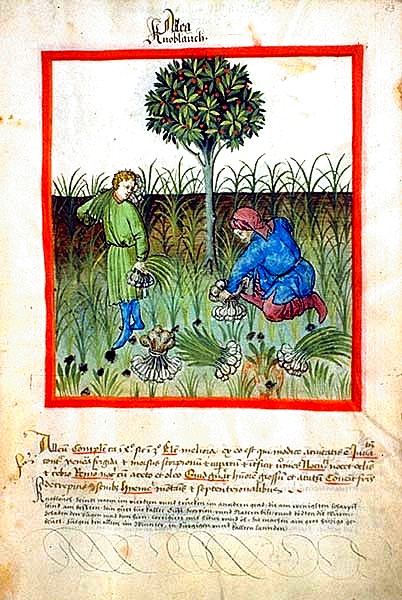Lessico
Elluchasem Elimithar
Ibn Butlan

Ibn
Butlan und zwei seiner Schüler
Autorenbild aus dem Wiener Tacuinum Sanitatis, fol. 4. recto (1390)
Elluchasem Elimithar è il nome latino di Abu-l-Hasan al-Mukhtar ibn al-Hasan ibn Abdun ibn Sa'dun ibn Butlan. Medico cristiano, fiorì a Bagdad intorno al 1063 e morì probabilmente ad Antiochia. Scrisse delle tavole sinottiche di igiene, dietetica e medicina domestica, tavole sinottiche probabilmente da lui ideate e che furono sviluppate da ibn Jazla sempre nella seconda metà dell’XI secolo. Ibn Butlan è diventato famoso per il suo Tacuinum sanitatis di cui si parla oltre. Vale la pena puntualizzare che il vocabolo taccuino è derivato dall'arabo taquim - o taqwim che trascrivere si voglia - che propriamente significa giusto ordine, latinizzano nel Medioevo in tacuinum. Anticamente il tacuinum indicava un manuale a carattere enciclopedico, specialmente di precettistica medica. Anche almanacco, lunario astrologico. Oggi per lo più indica un libretto con fogli bianchi per appunti, prevalentemente tascabile.
L’opera di Elluchasem prende appunto il nome di Tacuinum Sanitatis ... de sex rebus non naturalibus... conservandae sanitatis, recens exarati. Tacuinum sanitatis, translated from his Taqwim al-sihha, is his major work. Tacuinum is a crude latinization of the Arabic word taqwim, meaning 'straightening out,' or 'bringing into an order.' Thus the title can be translated as System of Health. It treats of the 'Maintenance of Hygiene,' and is highly original both in content and organisation. Divided into six parts, the first deals with air, which concerns the heart. The second is on the right use of food and drink, the third on movement and rest. The fourth is on the problem of prohibiting excessive wakefulness, the fifth is on maintaining the balance of the humours. The last part is on regulating the emotions. The use of tables is borrowed from astronomical literature, and had a decisive influence on the presentation of medical theories. Many foodstuffs and dishes, such as pomegranate, sycomori (mulberry), nabach, dates, jujube, camel, madua (meat cooked with sour milk), haribisia, sumacheria and rumania, evoke a flavour of Arabic cuisine. 'Pomegranates were so closely associated with the Arabic world in the northern mind that Europeans were convinced ... that they were "so called after the Moorish kingdom of Granada" ... Romania, the name of a dish that appears in a fourteenth century Italian cookbook, is derived from rumman, Arabic for "pomegranate," and its recipe is very similar to that of a dish called rummaniya in "A Baghdad Cookery Book." In Europe the pomegranate was used both for its juice and its seeds' (Peterson, Acquired Taste p. 11). Neither the translator, nor the Arabic manuscript from which the translation was made is known, although André Simon states that it was translated by a Jew named Faragus: several manuscripts of the Latin translation exist, and a facsimile of one has been published. A translation into German was published in 1533.
polybiblio.com/watbooks/1970.html
Tacuinum sanitatis casanatensis (XIV century)
The Tacuinum (sometimes Taccuinum) Sanitatis is a medieval handbook on wellness, based on the Taqwin al-sihha ("Tables of Health"), an eleventh-century Arab medical treatise by Ibn Butlan of Baghdad, or Elluchasem Elimithar; it exists in several variant Latin versions, the manuscripts of which are profusely illustrated. Though describing in detail the beneficial and harmful properties of foods and plants, it is far more than a herbal. It sets forth the six essential elements for well-being:
sufficient
food and drink in moderation,
fresh air,
alternations of activity and rest,
alternations of sleep and wakefulness,
secretions and excretions of humours, and finally
the effects of states of mind.
Illnesses result from imbalance of these elements, therefore a healthy life is lived in harmony.
The treatise translated into Latin in mid-thirteenth-century in Palermo, where it continued an Italo-Norman tradition as one of the prime sites for peaceable inter-cultural contact between the Islamic and European worlds
The Tacuinum was very popular in Western Europe in the Late Middle Ages; an indication of that popularity is the use of the word taccuino in modern Italian to mean any kind of pocket handbook, guide, notebook.
In addition to its importance for the study of medieval medicine, the Tacuinum is also of interest in the study of agriculture and cooking; for example, the earliest identifiable image of the carrot — a modern plant — is found in it.

Harvesting
garlic, from Tacuinum sanitatis, 15th century
Paris Bibliothèque nationale
Illustration du Tacuinum sanitatis - une ruche
Le Tacuinum (également appelé Taccuinum) Sanitatis est un manuel médiéval sur la santé, basée sur le Taqwin al-sihha (Tableaux de santé), un traité médical arabe écrit par Ibn Butlan ou Elluchasem Elimithar; il existe dans nombreuses versions latines, les manuscrits sont profusément illustrés.
À la fin du Moyen-Âge, le Taccuinum est très populaire en Europe de l'ouest; une indication de cette popularité est l'utilisation du mot taccuino en italien moderne qui désigne n'importe quel sorte de manuel de poche, guide ou cahier.
En plus de son importance pour l'étude de la médecine médiévale, le Taccuinum est également intéressant pour l'étude de l'agriculture et de la botanique. A titre d'exemple, on trouve la première illustration d'une carotte qui est une plante moderne pour l'époque.